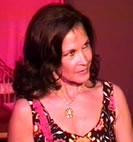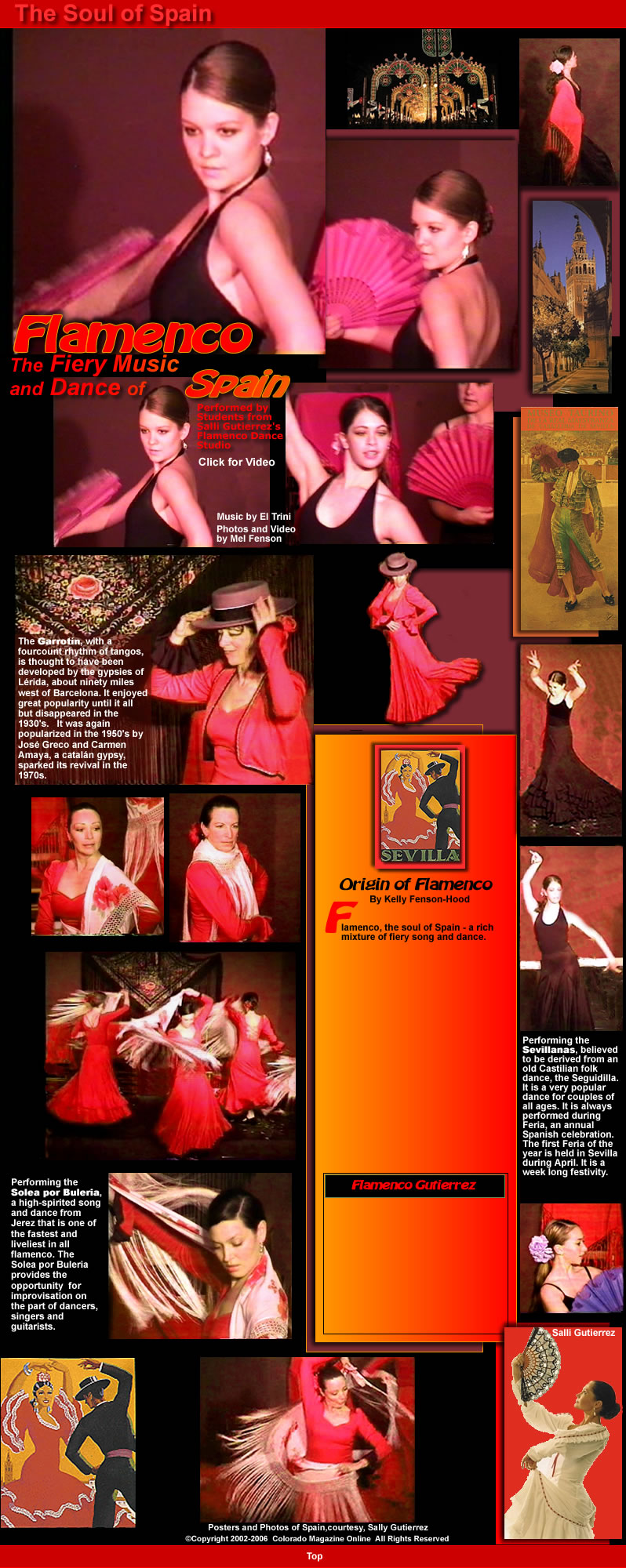They
file in slowly, their costumes aflame in red, they have attitude - backed
by over two hundred years of cultural tradition. The raspy voice of a Flamenco
singer rises over the strumming of a Spanish Guitar. The music is rich! The
sound pulsates over the audience as the staccato of the dancer's shoes raps
on the wooden dance floor and mesmerizes the audience. The dancers obey a
choreography that has stretched from the old country to America as they clap
their hands in unison to the fiery music of Spain.
These performers are students of Salli Gutierrez ‘s dance school, They
provided a stunning performance at Jester’s Dinner Theatre in Longmont,
during a recent event presented annually by the school. The colorful dances
ranged from Sevillanas to a Fandango, a Garrotin, a Solea por Buleria, and
a Tango.
Salli has danced since the age of 10. She became involved in ethnic dance
forms, while a student at the University of Colorado. While studying at the
Pan American University in Texas, she danced with the university’s nationally
acclaimed Ballet Folkloric de Pan American. After finishing her masters degree
in ESL and Spanish, Salli went abroad to study dance in Spain. She was trained
by a number of well known instructors, including: Marisol Moreno from Madrid,
Mercedes Ruiz from Jerez De La Frontera, Rocio Marquéz and Alicia Marquéz
from Sevilla, and Pacita Tomás y Joaquin Villa from Madrid. She also
studied with Debra Belo "La Furia" in Washington D.C., the late
"Tibu" of New York, José Molina of New York, "Quique"
of Argentina, and Manolo Vargas and Maria Elena Anaya of Mexico.
Salli teaches Flamenco Classes at her own school, located in Longmont, Colorado,
which offers multiple levels of dance training ranging from beginners through
advanced techniques and provides performance opportunities for students. She
also teaches at the Theatre and Dance Department at the University of Colorado
on the Boulder Campus and continues to perform Flamenco professionally .

Salli Gutierrez
More
information about
Flamenco
classes
is available from Salli’s website:
www.spain-connection.com
Top
Although
its origins are unclear, Flamenco is thought to have originated with nomadic
Gypsies, who lived in India. As they moved from place to place, they adopted
local music to their own style. Flamenco evolved over time and took on a Spanish
influence when Gypsies intermingled with Moorish culture from Andalucia, a
region in southern Spain. Flamenco is also influenced by Jewish, Catholic
and other ethnic musical traditions. Legend also suggests that the soldiers
of the Spanish-Belgian territories influenced Flamenco. These Flemish soldiers
were known for their self-confidence, style, and pride - an attitude which
embodies the spirit of Flamenco, a characteristic Gypsies also possess.
In Spain in 1492, King
Ferdinand and Queen Isabella initiated the Reconquista One, a new law that
stated everyone living under their domain was to convert to and live under
Christianity. Anyone who resisted would be punished with the most severe punishment,
being death by fire.
According to legend, during
this time of struggle, minority groups, including Muslims, Gypsies and others
came together and supported each other under the new rule. As a result of
this social interaction and cultural blending, flamenco evolved further and
began to be recognized as a style.
The first literary reference
to flamenco appeared in 1774 in the "Cartas Marruecas," in the village
of Cadalso. Jerez De La Frontera and Triana created the first flamenco schools,
between 1765 and1860. The flamenco became popular in music cafés and
bars during its Golden Age, between 1869 and 1910. Over the centuries, flamenco
has changed and transitioned into what it is today.
Flamenco is composed of
cante, the song; baile, the dance; and guitarra, the
guitar. Other components include: palmas, hand clapping; zapateado, rhythmic
toe and heal clicking; and jaleo, finger snapping.
There are three main forms
of flamenco: Grande or Jondo, meaning grand or deep; Intermedio,
meaning intermediate; and Chico, meaning small. Grande flamenco consists
of, "intense, profound songs, tragic in tone, and imbued with duende
- the transformation of the musician by depth of the emotion." Intermedio
flamenco is less serious than Jondo - occasionally possessing an "oriental
sound." Chico flamenco is made up of light songs of enthusiasm, love,
and nature.
The singer is the center of the flamenco group. The dancer acts as the physical
interpreter - through body movements - of the words and emotion expressed
by the singer. The dancing can include strategic footwork - with heal and
toe tapping, hand clapping, and intricate arm and body movements. The guitarist
accompanies the singer and dancer with melodies. The guitarist generally follows
a classical guitar technique by plucking the strings with his fingers. Often,
flamenco guitarists will shape their fingernails in such a way that when the
string is plucked in a certain way, a very distinctive sound and tone is created.
Another unique aspect of the flamenco guitarist is the strumming pattern,
in which the guitarist uses only one finger at a time to pluck a specific
string and then uses the back of the fingernail to pluck the string in the
opposite direction.
Information for this story
was gathered from web sources.
Top


